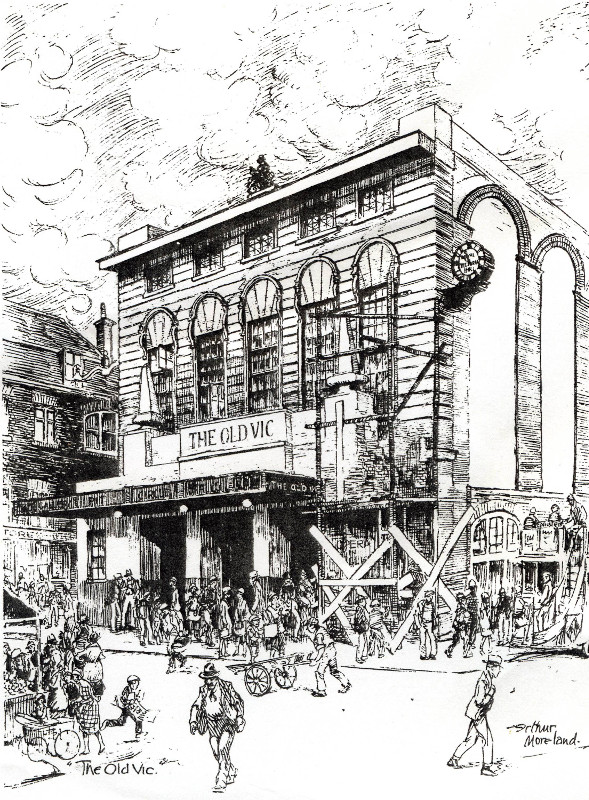Old Vic (London) Archive
Overview
Established in 1818 as the Royal Coburg Theatre, what we know today as The Old Vic Theatre was owned by a number of different companies under different names and hosted a range of house and visiting theatre groups, until leading Victorian social reformer Emma Cons acquired the leasehold for the theatre in 1880. In 1891 the freehold was bought by the charity, the Royal Victoria Hall Foundation.
In 1898 Emma Cons’ niece Lilian Baylis came to work at the Theatre, aged 23. When Emma Cons died in 1912, Baylis took over as manager and lessee and became one of the most important figures in British theatre, instrumental in establishing or strongly influencing the development of the National Theatre, The Royal Ballet, English National Opera and The Royal Ballet School.
From 1914 - 1921, Baylis mounted the complete First Folio, the first undertaking of its kind by a theatre. Baylis took over the Sadler’s Wells theatre in 1931 with the aim to make opera and dance more widely seen. The two venues alternated drama, opera and ballet until 1934 when opera and ballet moved to Sadler’s Wells. Sybil Thorndike, John Gielgud, Ralph Richardson, Edith Evans, Michael Redgrave, Peggy Ashcroft, Alec Guinness, Laurence Olivier, Charles Laughton, Flora Robson, Marius Goring and James Mason all joined the company in this inter-war period. Lilian Baylis died in 1937.
The building was damaged in 1940 during air raids and the company temporarily relocated its headquarters to Burnley. The Theatre was reopened in November 1950 and became a Grade II* listed building in 1951; Richard Burton and Judi Dench were early performers at this time.
The Joint Council of The Old Vic and National Theatre was established in 1946. When Laurence Olivier was appointed first director of the National Theatre in 1962, The Old Vic governors offered the theatre as its temporary home and The Old Vic company disbanded. It is at this point that The Old Vic Conmpany archive held here at the University of Bristol formally ends.
The National Theatre company opened at The Old Vic with Hamlet, starring Peter O’Toole. Over the next 13 years the National Theatre Company worked at the Old Vic Theatre, while waiting for its new home to be completed. In 1970 money from recent surpluses were used to finance the Young Vic, which served the National as a studio theatre until 1974 when it became home to a separate company. In 1976, under Peter Hall, the move to Denys Lasdun's National Theatre building on Southbank took place. Although our Old Vic Archive does hold a small number of documents from this period, the main body is stored at The National Theatre Archive.
The National’s last performance at The Old Vic before moving to the South Bank was “Tribute to the Lady”, with Peggy Ashcroft playing Lilian Baylis, Gielgud and Richardson were among those taking part. In her curtain speech Ashcroft repeated Baylis’ threat to come back and haunt The Old Vic should her and her aunt Emma Cons’ work ever be put at risk.
After 1976 the Royal Victoria Hall Foundation leased the theatre to visiting companies and in 1977 it became the home of the Prospect Theatre Company. Their productions included Hamlet with Derek Jacobi, Antony and Cleopatra with Alec McCowen and Dorothy Tutin and Saint Joan with Eileen Atkins. In 1982, The Royal Victoria Hall Foundation sold the theatre to Canadian entrepreneur Ed Mirvish.
What the collection holds
The Old Vic Theatre London archive dates from its foundation in 1818 as the Royal Coburg Theatre, to 1963, when the Theatre became the temporary home of The National Theatre Company. Although the official Old Vic archive terminates in 1963, business documentation generated by The Royal Victoria Hall Foundation, the charity which owed the freehold of The Old Vic from 1891 - 1982 has been absorbed into the Old Vic Archive series reference OV/RVHF.
While it does not formally hold documentation related to The London Old Vic Theatre after 1982, successive Old Vic admistrators have donated a small number of documents and marketing materials periodically until present day, which have been incorporated into this collection.
The online catalogue for this collection can be viewed here:
OV - The London Old Vic Archive
Related Collections
We also hold some material related to Actors, Writers, Directors and Designers who have been involved with productions at The Old Vic. Explore our online catalogue here.
Old Vic researchers will find the period 1979 - 1998 well represented in the Andrew Leigh Collection. Andrew Leigh was General Manager and Executive Producer at The Old Vic from 1979 until January 1998, employed respectively by The Old Vic Company (Prospect Productions), which went into liquidation in 1981, the Royal Victoria Hall Foundation and, finally, from 1982 to 1998 Ed Mirvish Enterprises Ltd (EME).
Much of the The Iain Mackintosh Collection is related to the Prospect Theatre Company and its tenure at the Old Vic 1977 - 1982.
We hold the archive of producer and actor Tom Vaughan (1911 - 1994), who also served as Governor of The London Old Vic, Chair of the Royal Victoria Hall Foundation and Drama Critic for The Morning Star.
Following the sale to Ed Mirvish, The Royal Victoria Hall Foundation was no longer legally or administratively connected to the modern Old Vic Theatre, although it holds the annual Lilian Baylis Award ceremony there, by kind permission of the current management. The RVHF is still funded principally from the invested proceeds of the sale of The Old Vic Theatre in 1982, plus subsequent gifts and bequests. This RVHF collection, from 1982 onward can be seen here.
Further information
Further Reading
"The Old Vic Story - a Nation's Theatre" by Peter Roberts
"The Old Vic Theatre- A History" by George Rowell
